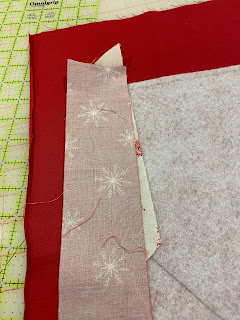I always love a good Christmas project and these festive placemats are fun and easy to make. The quilt-as-you-go method is appealing and the fact that they can be bound with the backing is ideal for me.
First - choose your favorite holiday fabrics. You'll need some fusible fleece or regular thin batting. The fusible fleece isn't too deep and easily adheres to the backing. Pick a coordinating backing as this will also serve as your binding. This piece should be at least 14" x 18" . I always use a backing that is a bit bigger as it gives me 'wiggle room'. You'll need thread that will show nicely as this will be quilting on the back of your placemats.
I like to use a template which I make out of simple printer paper pieced together. It easily shows how much fabric I require and saves having to measure for every placemat.
I also make a template for the fusible fleece which is 12" x16".
Draw a slanted line on a top corner and the opposite bottom corner of the fusible fleece. No specific measurements here - just draw and angle as you like.
Then press the batting onto the center of the backing, being sure to leave enough fabric (at least 1") all around. This will eventually be the self-binding. You can easily trim later if you have too much. Err on the side of caution as it's always better than having too little material.
TIP: Every time you start to sew, put the needle down and up once to catch the bobbin thread. When you finish a seam, bring your bobbin thread to the top and tie it. This makes a neater backing and saves a lot of time sewing in ends.
Important - Start as accurately as you can at the top of the fleece and end exactly on the diagonal line. It is a bit tricky to see the line and sometimes I'll estimate or make a crease in the fabric at the line so I'll know where to stop.
Press each seam before placing the next fabric strip.
Once you've sewn the strips from left to right, it should look like this.
Now you'll use the same method to sew fabric to the diagonal corners. Line your first strip up with the diagonal line, making sure the strip covers all the ends of the vertical pieces already sewn. If not, move it down slightly. Sew this strip from edge to edge remembering to pick up your bobbin thread at the beginning and end of the seam.
Once you've sewn the diagonal corners, it should look like this.
Trim the excess fabric along the sides, top and bottom. Place the placement right side down on cutting mat. Fold back the backing and batting along each side. Place the cutting ruler edge slightly to the right of the batting. Again - Be very careful as you don't want to cut the backing fabric or batting, just the excess strip fabric.
Here's the back of my placemat. You can see it doesn't have any loose threads to hide because I picked up the bobbin thread at the beginning and end of each seam.


































